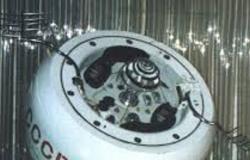Cosmos 482 It is the technical name given to the space probe that the Union of Soviet Socialist Republics (USSR) launched the space on March 31, 1972. It was a mission framed in the Venera program which was carried out to explore the planet Venus. Nevertheless, It was a failed mission and after 53 years It will re -enter the Earth this Saturday, May 10 in “an un controlled process,” experts called.
This artifact It measures a meter in diameter and weighs 495 kilos. It has an upper cover that is supposed to be detached when entering the atmosphere for deploy a parachute of 2.5 meters and expose the antenna and instruments, according to information provided by the National Aeronautics and Space Administration (NASA). However, It is not known if it still works, since it depends on batteries and there is no control over the device.
The space probe has temperature, pressure and density sensors, as well as an accelerometer, a radio altimeter, an anemometer, a gamma ray spectrometer, a gas analyzer, visible photometers and radio transmitters. Even so, As corresponds to an artifact released by the USSR decades ago, there is no control over it or official information.
The European Space Agency (ESA) carries out the reentry prediction of the Venus venerate landing module of the Soviet era and reported: “The Space Waste Office current +/- 3.28 hours ”. This means that entrance It is scheduled for 3:37 in the morning (Argentine time) of May 10, 2025 and that there may be a variation of between three hours or so. Therefore, it can fall at 00:30 or 6:30.
Another great unknown is where the Soviet space probe will fall. The diagrams published by ESA reveal that the accident It could happen anywhere in the world, from London to the South American border between Argentina and Chile. For its part, NASA revealed that it could collide at some point between 52 degrees of north and south latitude; This can be in some European regions, partly from the border between Argentina and Chile, In Patagonia in Argentina or in the Atlantic, Indian and Pacific Oceansamong other places.
On the other hand, the Caribbean Astronomy Society (SAC) warned that the exact date can be advanced or delayed by the activity in the sun, since when the sun is more active, the atmosphere is heated and expanded. “This causes objects in low orbits to feel greater friction or atmospheric braking and begin their reentry before foreseen”, He said. This realizes that there may be a variation in the hour and the planned place of the fall of Cosmos 482.
It is important to mention that, despite the fact that the activity of the sun can influence, The space probe was designed to support extremely hard conditions of the hostile atmosphere of Venus and also endure a lot of pressure. So this worries the space community very much, since unlike ships and other artifacts that disintegrate, give off or even burn Upon entering the atmosphere, Cosmos 482 could survive its re -entry to Earth after 53 years.






